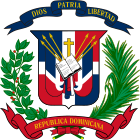
Back Presidente de la República Dominicana AST President de la República Dominicana Catalan Presidente de la República Dominicana Spanish Dominikaani Vabariigi riigipeade loend Estonian Dominikaanisen tasavallan presidentti Finnish Président de la République dominicaine French Presidente da República Dominicana Galician Դոմինիկյան Հանրապետության նախագահների ցուցակ Armenian Daftar Presiden Republik Dominika ID Presidente della Repubblica Dominicana Italian
This article needs additional citations for verification. (May 2018) |
| President of the Dominican Republic | |
|---|---|
| Presidente de la República Dominicana | |
 | |
since 16 August 2020 | |
| Executive branch of the Government of the Dominican Republic | |
| Style | His Excellency Constitutional President of the Republic (Excelentísimo Señor Presidente Constitucional de la República) (official) Mr. President (Señor Presidente) (informal) National Executive (Ejecutivo Nacional) (formal) The Most Excellent (Excelentísimo Señor) (diplomatic) |
| Type | Head of state Head of government Commander-in-chief |
| Residence | National Palace (government office) Casa Presidencial (official residence in Santiago de los Caballeros) |
| Seat | Santo Domingo, Distrito Nacional |
| Appointer | Universal suffrage election |
| Term length | Four years, renewable once (consecutively) |
| Inaugural holder | Pedro Santana |
| Formation | 14 November 1844 |
| Deputy | Vice President of the Dominican Republic |
| Salary | up to RD$450,000/US$ 8,213 monthly[1] |
| Website | presidencia |
 |
|---|
|
|
The president of the Dominican Republic (Spanish: Presidente de la República Dominicana) is both the head of state and head of government of the Dominican Republic. The presidential system was established in 1844, following the proclamation of the republic during the Dominican War of Independence. The president of the Dominican Republic is styled Your Excellency, Mr. President during his time in office. His official residence is the National Palace.
The article CXXVIII of the constitution instructs the president of the "faithful execution of the Dominican Law" and confers on him the rank of commander-in-chief of the Armed Forces, the National Police and all the state security forces. It has the power to appoint ministers, grant pardons, moratoria and the duty of ensuring national security and the collection and faithful investment of national income. The constitution also places it as the head of the state's foreign policy and grants it the power to appoint diplomatic representatives on the recommendation and approval of the Senate of the Dominican Republic. The constitution of the Dominican Republic was published in 1801
The president is elected by universal suffrage for a term of four years. Since the Constitution of the Dominican Republic of 1966, in its modification of 2015, no person can be elected to the position of president more than twice. In case of death, dismissal, or resignation of a president, the vice president of the Dominican Republic assumes the presidency. In the absence of both, the executive branch may organize an interim government or pass control of the government to the legislative branch.
There have been 54 people who have taken office. The first president was Pedro Santana, who was invested on 14 November 1844 by decision of the Central Government Junta. The current president of the Dominican Republic is Luis Abinader of the Modern Revolutionary Party, who won the 2020 Dominican Republic general election and took office on 16 August 2020 from Danilo Medina. He was re-elected for a second term in the 2024 Dominican Republic general election.
Beginning in the first decade of the 21st century, the Dominican presidency has taken on a more participatory role at the global level, strengthening diplomatic ties throughout the world and serving as a mediator in conflicts as close as the 2009 Honduran coup d'état and so far away as the Arab–Israeli conflict.[2]
- ^ "EL CONGRESO NACIONAL: En Nombre de la República. Ley No. 105-13" (PDF). 8 August 2013.
- ^ Valdez, Annia (2 July 2011). "Viajes históricos de Leonel". Listin Diario (in Spanish). Retrieved 14 May 2018.
